In this article I’ll be going over 11 yellow birds that can be found throughout Utah so, continue reading for a more detailed look at each bird below.
- Western Kingbird
- American Goldfinch
- Western Tanager
- Summer Tanager
- American Yellow Warbler
- Yellow Headed Blackbird
- Lesser Goldfinch
- Yellow Rumped Warbler
- Evening Grosbeak
- Common Yellowthroat
- Yellow Breasted Chat
11 Yellow Birds In Utah
1. Western Kingbird (Tyrannus Verticalis)
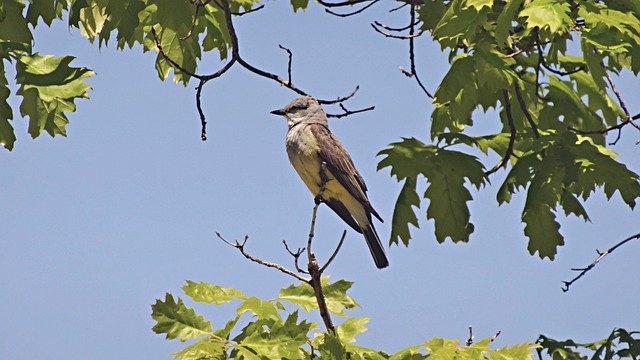
- Size: 20 – 24cm
- Weight: 37 – 46 grams
- Wingspan: 38 – 41cm
Western Kingbirds are summer and spring residents within Utah as this is the season within which these birds breed.
These birds are recognised by their gray head, back and wings, a pointy black beak with the lower half of their body mostly yellow. Females are duller in color than males and are also a lot more gray from head to breast too.
You’ll often find the western kingbird perched around open country, grasslands, dry savannas, valleys, lowlands, open farms, woodlands, agricultural fields and sagebrush.
Western kingbirds are known to eat mostly insects which include wasps, bees, beetles, grasshoppers, flies, true bugs, caterpillars, moths as well as other smaller fruits and berries.
These birds are known to live for around 6 years in the wild.
2. American Goldfinch (Spinus Tristis)

- Size: 11 – 13cm
- Weight: 11 – 20 grams
- Wingspan: 19 – 22cm
American goldfinches are year round residents across northern Utah and non-breeding residents in the remainder of the state.
These finches are recognised by their yellow, white and black plumage. Their wings are black and white, their forehead is distinguished by the small black patch on it, their under tail is white with the remainder of the body a bright yellow color. Females are far less vibrant with hints of yellow however, are mostly a light brown color.
American goldfinches are found around the edges of forests and plains, around areas filled with brush and thistle plants.
These finches tend to mainly consume seeds that come from the daisy composite family, seeds from weeds, from trees like birches and elm trees, buds, the occasional insect, maple sap, and berries.
American goldfinches are known to live between 2 – 4 years in the wild and upto 9 years in captivity.
3. Western Tanager (Piranga Ludoviciana)

- Size: 16 – 19cm
- Weight: 24 – 36 grams
- Wingspan: 27 – 31cm
You’ll be able to spot western tanagers breeding in most of Utah, which is typically within the spring and summer months.
Western Tanagers are recognised by their red head, yellow body and their gray wings with yellowish/white stripes. The females are yellow too although it’s color is more dirty yellow with gray/black wings.
Western tanagers can be found within Open conifer or mixed forests.
Within these environments they will consume a variety of food sources like smaller fruits and berries like mulberries and elderberries as well as insects like wasps, bees, ants, beetles, grasshoppers, termites, cicada among other smaller insects.
Western tanagers tend to live upto 7 – 8 years in the wild.
4. Summer Tanager (Piranga Rubra)

- Size: 15 – 18cm
- Weight: 25 – 35 grams
- Wingspan: 23 – 28cm
Summer tanagers can be found across the south western region of Utah in their spring and summer breeding months.
Female summer tanagers are small, bright and yellow birds. Their male counterparts are completely red which shows the significant sexual dimorphism between the 2 genders.
You’ll find these birds hanging around open wooded areas, especially in areas with oaks.
As for what these tanagers eat, it includes mostly bees and wasps but they will occasionally go for smaller fruits and berries in bushes or trees.
These little birds are known to live between 3 – 5 years in the wild.
5. American Yellow Warbler (Setophaga Petechia)
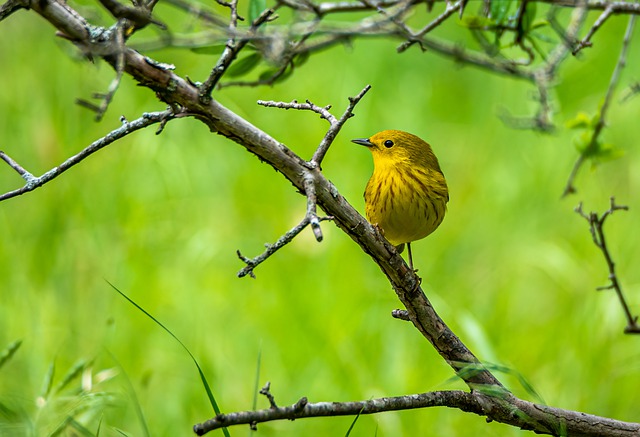
- Size: 12.5 – 13cm
- Weight: 8 – 16 grams
- Wingspan: 16 – 22cm
You’ll find American yellow warblers in all of Utah throughout their breeding spring and summer seasons.
American Yellow Warblers are recognised by their yellow plumage with streaks of brown on their feathers and back. The males have a few more patterns to their plumage but, both the males and females are mostly yellow in color.
As for the habitats in which these little avians tend to spend the majority of their time, it would be bushes, swamp edges, streams, and gardens.
Yellow warblers tend to consume insects and berries with 2/3 of their diet mostly consisting of small insects like caterpillars,
beetles, damselflies, treehoppers, and more.
These little warblers are known to live upto 10 years although most warblers don’t live nearly as long as that. Often a warblers will live closer to 2 – 5 years in the wild as opposed to the full 10.
6. Yellow Headed Blackbird (Xanthocephalus Xanthocephalus)
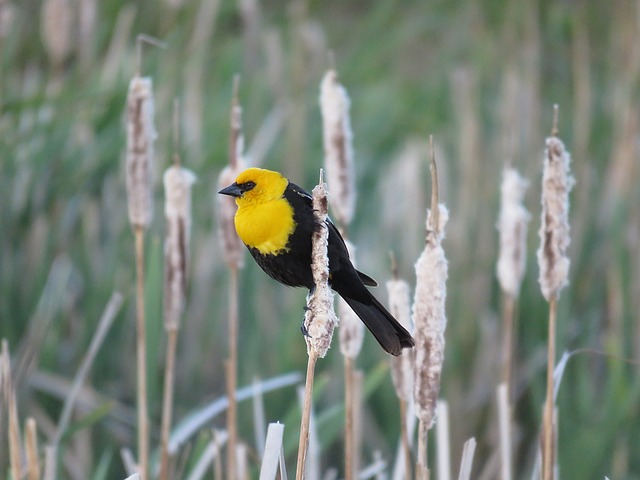
- Size: 20 – 25cm
- Weight: 44 – 100 grams
- Wingspan: 36 – 44cm
These blackbirds are breeding residents in the majority of Utah, other than the southeast region of the state where they’ll stick around when migrating.
Yellow headed blackbirds are recognised by their obvious vibrant yellow face feathers, black wing feathers, beak and eyes. Their look is definitely more unique than the average black and yellow bird on his list but, their diet is more of the same.
This is because yellow headed blackbirds mostly consume seed and insects. The insects they consume include
beetles, caterpillars, grasshoppers, ants, wasp among other smaller insects. They also consume the occasional berry.
Like other blackbirds yellow headed blackbirds tend to spend the majority of their time in gardens, thickets, hedges, broad-leaved environments and coniferous forests.
Yellow headed blackbirds are known to live for around 11 years on average whilst the longest known one happened to hit the 18 year mark.
7. Lesser Goldfinch (Spinus Psaltria)

- Size: 9 – 12cm
- Weight: 8 – 11.5 grams
- Wingspan: 20 – 22cm
Lesser goldfinches can be found in northern Utah year round and in the remainder of the state when they are not breeding, throughout the fall and winter months.
These finches are recognised by their black wings, back and upper head with the lower half of their body mostly yellow. A females plumage is similar but the darker elements are far duller.
Lesser goldfinches are often located in open brushy country, open woods, wooded streams, gardens that are generally semi-open as they like being around thickets and trees that are close to open weedy fields.
They are known to eat mostly seed with insects in the mix to make up for the protein where they specifically enjoy eating thistles, the buds on trees and berries too.
Lesser goldfinches tend to live for around 3 – 6 years in the wild and upto 10 years in captivity.
8. Yellow Rumped Warbler (Setophaga Coronata)
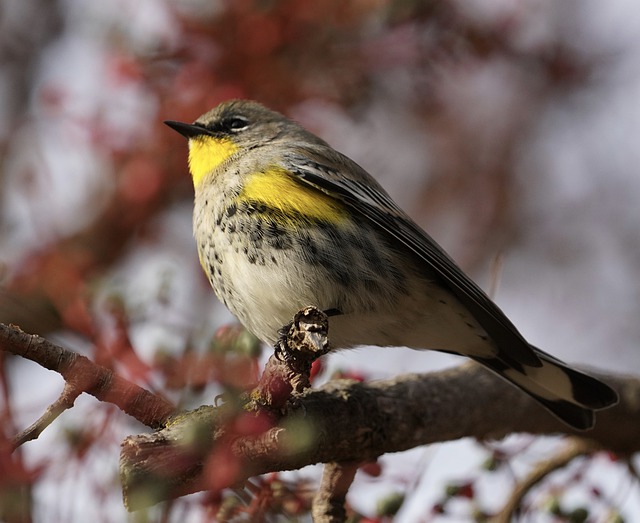
- Size: 12 – 14cm
- Weight: 12 – 13 grams
- Wingspan: 19 – 23cm
Yellow rumped warblers can be found in the majority of Utah when breeding.
These warblers are recognised by their gray and black wings, tail, back, and head with a black mask like stroke across the eye, with yellow elements on the upper end of the wing, on the top and around the upper breast area. Females tend to be a gray/brown color whilst males are a little more vibrant.
Yellow rumped warblers are often found around coniferous forests, especially during the breeding season whilst in winter they can be found in open areas with fruiting shrubs.
As for what they eat, it includes insects and berries where the insects are caterpillars, wasps, grasshoppers, gnats, aphids, beetles, and spiders with the berries including bayberry, juniper, wax myrtle, poison ivy, and others.
Warblers are known to live upto 10 years in the wild.
9. Evening Grosbeak (Coccothraustes Vespertinus)
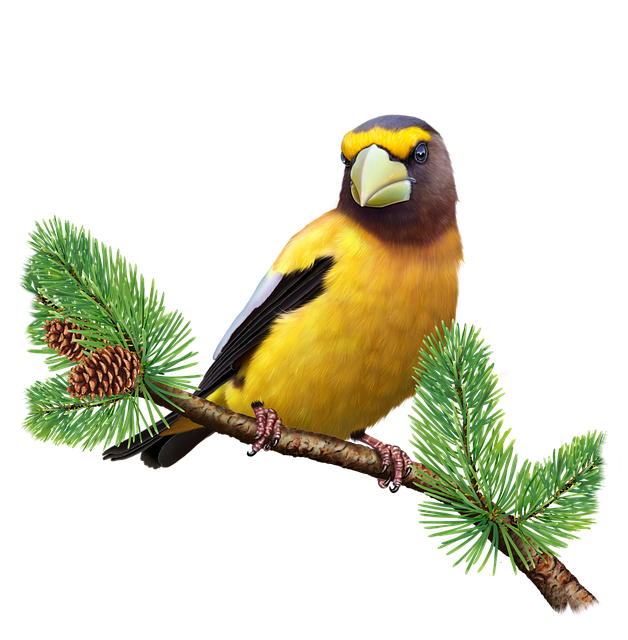
- Size: 16 – 22cm
- Weight: 50 – 60 grams
- Wingspan: 30 – 36cm
Evening grosbeaks can be found in northern Utah year round and in the remainder of the state throughout their non-breeding season.
These grosbeaks are recognised by their yellow, black and white plumage where their belly and forehead is yellow, with their wings a black and white color. Females are a mostly cream/gray color with elements of yellow around the neck area.
These birds can be found in habitats such as coniferous and mixed forests where they’re most often associated with spruce and fir in northern forest.
As for what evening grosbeaks mostly eat sunflower seeds among other seeds, berries, and buds of trees and shrubs—especially maples.
Evening grosbeaks are known to live for around 15 years.
10. Common Yellowthroat (Geothlypis Trichas)
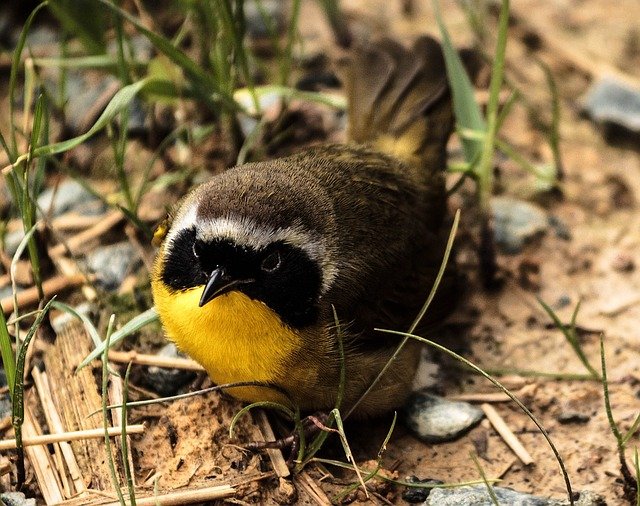
- Size: 11 – 14cm
- Weight: 11 – 15 grams
- Wingspan: 15 – 19cm
You’ll find common yellowthroats in northern and eastern Utah when they happen to breed.
Common yellowthroats are recognised by their mostly light brown/dirty yellow plumage from their head to tail whilst their throat is a bright yellow color. Females are mostly yellow with small elements of yellow on their tail and chin whilst males have more elements of black on their face.
As for where you can find these yellowthroats, they can be located around swamps, marshes, wet thickets, edges where they will often breed within wet marshes as well. They also nest within briars, moist brushy places, tangles of rank weeds and shrubbery along streams and overgrown fields.
Common yellowthroats are known to eat smaller insects like ants, spiders, and beetles along with seeds and smaller fruits like berries.
These avians can live for around 11 years in the wild.
11. Yellow Breasted Chat (Icteria Virens)

- Size: 17 – 19cm
- Weight: 20 – 34 grams
- Wingspan: 23 – 27cm
These yellow breasted chats are found throughout the majority of Utah when breeding. This tends to fall between the spring and summer months.
Yellow breasted chats are recognised by their gray/greenish back, wings and forehead, bright yellow chest and white/grayish underside of their lower half.
These avians like to spend the majority of their time within thickets among other dense grassy environments where bushes, shrubs and clearcuts are present.
As for the type of food these yellow breasted avians eat, they include small insects like bees, wasps, mayflies, grasshoppers, katydids, caterpillars, spiders among others small variants along with the smaller fruits and berries.
Yellow breasted chats also tend to live for around 5 – 8 years in the wild.
Amhil Khan, a dedicated nature enthusiast and the founder of BirdsOfTheWild.com, is a passionate advocate for the captivating world of avian wonders. With a deep-seated curiosity about the intricate lives of birds, Amhil’s journey began as a fascination and has evolved into a mission to inspire others to appreciate and protect these magnificent creatures.
Amhil’s love for birds led to the creation of Birds of the Wild, a platform where his expertise in ornithology, coupled with his captivating storytelling, provides readers with an immersive and educational experience. Through his lens and words, he captures the essence of birds in their natural habitats, offering a glimpse into their behaviors, migrations, and the ecosystems they inhabit.

